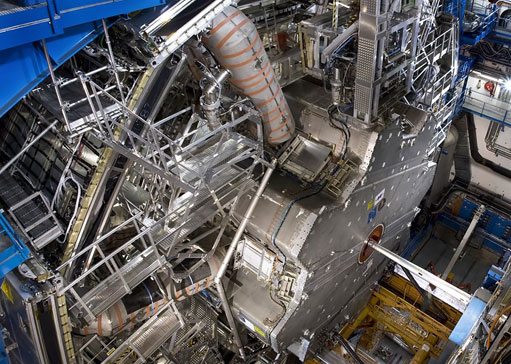
ATLAS e-News
23 February 2011
Keeping cool: Christmas fixes for the magnets and cryogenics
9 February 2010

Looking down on the end of the Barrel Toroid magnet during the endcap closure, May 2009 (Courtesy Maximilien Brice)
Facing a winter shutdown just weeks after the LHC got going for the first time was a bit of a disappointment for everyone itching to press ahead with the physics program. But for the magnet and cryogenics systems, the break presented an opportunity to make some unexpected but essential fixes ahead of the long 2010 run.
Problematic warming in the Barrel Toroid copper current leads was spotted early on in the continuous ATLAS run which began in October and ended with the winter shutdown. The leads, which carry a 20 kiloAmp current in parallel between the bus-bar system and the Toroid coil entry point, are meant to be kept at a steady room temperature of around 295 to 300 kelvin. But air in voids had apparently oxidised and degraded one of the connections over the course of the last three years, and by November its temperature had crept up to around 330 K.
“This is not dangerous, but we didn’t want to accept it for another 15 years,” comments Magnet System Project Leader Herman Ten Kate. Mid-run, opportunities to fully address the problem were limited, but a fun and ingenious temporary solution involved redirecting compressed air from elsewhere in the cavern and literally “splashing it across” the connections to cool it down. “That reduced the temperature by about five degrees, so it was good enough to survive until Christmas.”
In January, a permanent fix was applied: the connection was opened up, cleaned, brushed, and coated with silver paste to provide a continuous interface between the electrical surfaces and prevent air getting between the metals in the future.
Elsewhere, problems in the cryogenics caused the so-called ‘shield’ refrigerator to trip on December 6th. One day earlier, circuits on the refrigerator had been identified as clogged when an abnormal pressure drop was registered across charcoal powder absorbers used to filter the helium gas, and unbalanced heat-exchangers were spotted inside the refrigerator. They had become blocked, likely with frozen water vapour from traces of air within the system. The knock-on effect of this was that the Solenoid and Toriod magnets were off for three and four days respectively, whilst the shield refrigerator underwent a rapid regeneration. Fortunately, no major LHC fills happened during this period, so little important data was missed.
“Clogging of cold circuits due to impurities trapped in the system is a standard and known problem which normally should not occur more than once per year,” says ATLAS cryogenics expert Nicolas Delruelle about the build-up of impurities. The last occurrence had only been roughly six months before (May 29th), and so the contamination was at first attributed to a small leak somewhere in the cryogenic system or Solenoid. All the circuits checked out successfully in leak tests though, meaning that the impurities must have been already present in the system, possibly tucked away in a corner of pipe work on an un-used ‘dead end’ circuit somewhere. Minor interventions on the pipe work in June, coupled with a lack of available time to flush the pipes ahead of October’s run are likely to blame.
Similar contamination problems plagued the control dewar – the cryogenic reservoir which sits atop the Solenoid. Its 250 litres of liquid helium are used to feed the Solenoid cooling circuits and to keep the magnet power leads that run through it cool and in a superconducting state. Impurities in the liquid helium froze around two valves in the dewar, making it difficult to establish a correct fluid flow.
In both instances, a complete regeneration of the system was in order. The Solenoid and sheilding circuits were warmed to ambient temperature, and then the whole system was pumped, purged and rinsed repeatedly over several days. “Every time you do that with pure helium, you are diluting effective problems,” explains Herman. “When you do this four, five, six times, in fact you have diluted this pollution so much that it’s not a problem any more.”
The big cool down began again on Saturday January 23rd, with the start-
up of the shield refrigerator turbines. Liquid helium will run through
the solenoid again on Tuesday February 9th, and the power supply will
be switched on again that evening. The Toroid ramp-up will follow on
February 11th.
The plan for running is to have just one cryogenics regeneration per year, during the annual shutdown, but since there has not yet been any continuous cold run of more than seven months, this mode of working has yet to be tested. Nicolas is pretty confident though: “I think that during this shut down we’ve done a good flushing of all the Solenoid circuits, so hopefully the two cloggings that we had last year should not occur during 2010.”
 Ceri PerkinsATLAS e-News
|